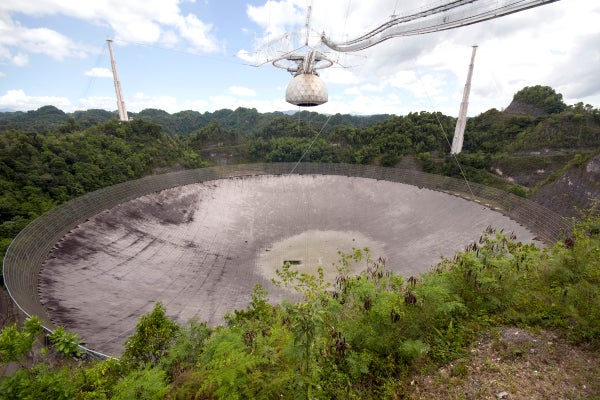One of astronomy’s most renowned telescopes—the 305-metre-wide radio telescope at Arecibo, Puerto Rico—is permanently closing. Engineers cannot find a safe way to repair it after two cables supporting the structure suddenly and catastrophically broke, one in August and one in early November.
It is the end of one of the most iconic and scientifically productive telescopes in the history of astronomy—and scientists are mourning its loss.
“I don’t know what to say,” says Robert Kerr, a former director of the observatory. “It’s just unbelievable.”
On supporting science journalism
If you're enjoying this article, consider supporting our award-winning journalism by subscribing. By purchasing a subscription you are helping to ensure the future of impactful stories about the discoveries and ideas shaping our world today.
“I am totally devastated,” says Abel Mendéz, an astrobiologist at the University of Puerto Rico in Arecibo who uses the observatory.
The Arecibo telescope, which was built in 1963, was the world’s largest radio telescope for decades and has historical and modern importance in astronomy. It was the site from which astronomers sent an interstellar radio message in 1974, in case any extraterrestrials might hear it, and where the first known extrasolar planet was discovered, in 1992. It has also done pioneering work in detecting near-Earth asteroids, observing the puzzling celestial blasts known as fast radio bursts, and studying many other phenomena. All of those lines of investigation are now shut down for good, although limited science continues at some smaller facilities at the Arecibo site.
Assessing the damage
The cables that broke helped support a 900-tonne platform of scientific instruments, which hangs above the main telescope dish. The first cable smashed panels at the edge of the dish, but the second tore huge gashes in a central portion of it.A high-resolution satellite image, produced at Nature’s request by Planet, an Earth-observing company, shows the extent of the damage wrought by the second cable; the green of the vegetation below shows through large holes in the dish. A second photograph, released this week by observatory officials, also reveals the destruction. They are the only public glimpses of the damage to date.
If any more cables fail—which could happen at any time—the entire platform could crash into the dish below. The US National Science Foundation (NSF), which owns Arecibo Observatory, is working on plans to safely lower the platform down in a controlled fashion.
But those plans will take weeks to develop, and there’s no telling whether the platform might crash down uncontrollably in the meantime. “Even attempts at stabilization or at testing the cables could result in accelerating the catastrophic failure,” said Ralph Gaume, the NSF’s head of astronomy, at a 19 November media briefing.
So NSF decided to close the Arecibo dish permanently. “This decision is not an easy one to make, but safety is the number-one priority,” said Sean Jones, head of NSF’s mathematical and physical sciences directorate.
The closure is likely to come as a shock to the wider astronomical community. “Losing the Arecibo Observatory would be a big loss for science, for planetary defense, and for Puerto Rico,” said Desireé Cotto-Figueroa, an astronomer at the University of Puerto Rico at Humacao, in an email prior to the announced closure.
NSF officials insist that the cable failures came as a surprise. After the first, engineering teams spotted a handful of broken wires on the second cable, which was more crucial to holding up the structure, but they did not see it as a major problem because the weight it was carrying was well within its design capacity. “It was not seen as an immediate threat,” says Ashley Zauderer, programme manager for Arecibo at the NSF.
Over the years, external review committees have highlighted the ongoing need to maintain the telescope’s ageing cables. Zauderer said that maintenance had been completed according to schedule.
Before this year, the last major cable problems at the observatory were in January 2014, when a magnitude-6.4 earthquake caused damage to another of the main cables, which engineers repaired. The ageing structure has suffered other shocks in recent years, including Hurricane Maria in 2017 and a series of smaller earthquakes in January of this year.
There is no estimate yet on the cost of decommissioning the telescope.
A legendary site
Some of the observatory’s scientific projects may be able to be transferred to other facilities, Gaume said—and that he expects scientists to propose where to shift their research to. Science does continue at other portions of the Arecibo observatory, which encompasses more than the 305-metre dish. They include two lidar facilities that shoot lasers into the atmosphere to study atmospheric phenomena.
Arecibo had been regularly upgraded, with several new instruments slated to be installed in the coming years. “The telescope is in no way obsolete,” says Christopher Salter, an astronomer at the National Radio Astronomy Observatory in Green Bank, West Virginia, who worked at Arecibo for years.
The observatory is also a major science-educational centre for Puerto Rico, fostering the careers of many astronomers and engineers. And it has become a part of the pop culture lexicon, featuring in major movies such as Contact, based on a Carl Sagan novel, and the James Bond film GoldenEye.
The last major radio telescope disaster happened in 1988, when a 300-foot-wide antenna at the observatory in Green Bank, West Virginia, collapsed one night due to structural failure.
This article is reproduced with permission and was first published on November 19 2020.
